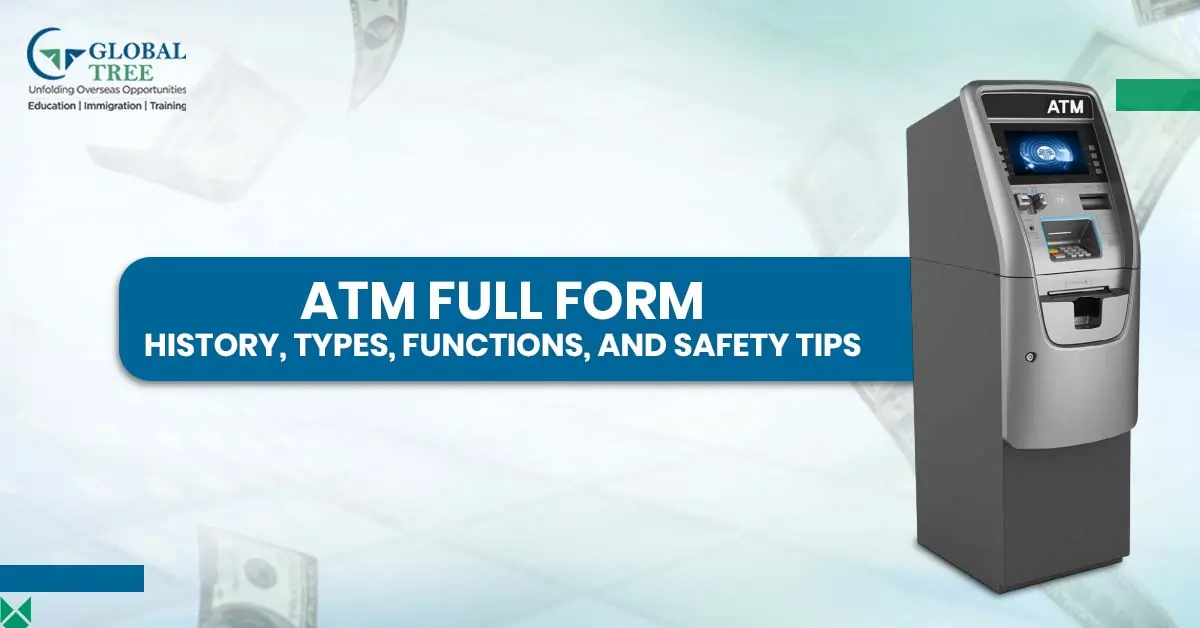ATM Full Form: History, Types, Functions, and Safety Tips

ATM Full Form
ATM - Automatic Teller Machine is an electronic machine used for financial transactions by banks.
Revolutionizing the banking industry, the longest waiting lines under the nose of the cashier in banks and waiting for our token number, holding the passbook with Withdrawal/deposit form days, ATM made our lives easier.
ATMs allow customers to have effortless financial transactions at any time without the need of visiting their respective bank. It is a self-service machine where customers can withdraw or deposit cash, check account balance, change passwords, etc without anyone's guidance.
History and Evolution of ATMs
Automated Banking isn’t a new concept. It dates back to the 1960s. In 1967, Barclays Bank in London introduced the world's first ATM, revolutionizing the banking industry by providing 24/7 access to cash. This innovation allowed customers to withdraw money outside of regular banking hours, enhancing convenience and accessibility.
(Read More: What is the full form of CRN: Importance and applications)
First ATM in History
The first ATM in the United States was installed by Chemical Bank in Rockville Centre, New York, on September 2, 1969. This machine marked a significant milestone in banking technology, allowing customers to perform basic transactions without the assistance of a teller.
Over the decades
ATMs have evolved significantly over the decades. Specially in India, significant ATMs evolution over decades can be observed. Arising from metropolitan cities, ATMs are now ubiquitous. Earlier designed solely for cash dispensing, modern ATMs now offer a wide range of services, including:
- Cash Deposits: Direct Cash deposit into Accounts.
- Check Deposits: With new scanning technology in ATMs customers can deposit checks without the need for deposit slips.
- Fund Transfers: Funds/ Money Transfers between linked accounts were made easy with ATMs without any need to visit bank branches.
- Bill Payments: Most ATMs are now facilitating Bill payments from the customer accounts directly.
- Mobile Recharge: Few ATMs offer Mobile Recharge options.
- Mini Statements: Transaction histories can be taken as copies printed from ATM machines.
Note: Heading abroad for studies? Your local currency won’t help! Understanding foreign exchange can make your study abroad smoother.
What are the 4 Types of ATMs?
Based on ownership and its functionality, ATMs are categorized into 4 types.
- On-site ATMs: ATMs located within the premises of the bank branch and are under the management of the respective bank.
- Off-site ATMs: ATMs located in places such as shopping malls, airports, residentials areas, public transportation depos, etc. Even though they are under control of banks, they will be placed in a location where there are no bank branches nearby. These Off-site ATMs are more useful for the customers for any financial emergencies.
- White Label ATMs: White Label ATMs are owned and operated by private non-bank organisations. These ATMs do not display any branding on machines. TATA Group in India introduced the first white label ATM.
- Brown Label ATMs: While the hardware and lease are owned by a service provider, the bank manages cash handling and network connectivity.
How do ATMs work?
The operation of an ATM involves several key components:
- Card Reader: Reads the magnetic stripe or chip on the customer's debit or credit card to identify the bank account.
- Keypad: Allows users to input their Personal Identification Number (PIN) and select transaction types.
- Display Screen: Provides instructions and displays transaction information to the user.
- Cash Dispenser: Dispenses the requested amount of cash.
- Printer: Offers receipts for transactions, detailing the transaction type, amount, and account balance.
- Network Connectivity: Connects the ATM to the bank's central system to verify account details and process transactions in real-time.
(Suggested Read: How many dollars should you carry to study in the USA?)
What Security Precautions are Necessary for an ATM?
Given the financial nature of ATMs, security is paramount. Measures include:
- Encryption: Sensitive data, such as PINs, are encrypted to prevent unauthorized access.
- CCTV Surveillance: Many ATMs are monitored by cameras to deter and record suspicious activities.
- Anti-skimming Devices: Protect against devices that illegally capture card information.
- Time-Locked Safes: Restrict access to cash inside the machine to specific times, reducing the risk of theft.
Know the Benefits and Features of ATMs
ATMs offer numerous advantages to both banks and customers:
- Convenience: Provide 24/7 access to banking services, allowing transactions outside of traditional banking hours.
- Accessibility: Located in diverse areas, ensuring customers can access services without visiting a bank branch.
- Efficiency: Reduce queues and workload in bank branches by handling routine transactions.
- Cost-Effective: Lower operational costs for banks by automating services that would otherwise require human tellers.
(You may also like: Here are the best tips on how to get a student loan for study abroad)
Challenges and Considerations
Despite their benefits, ATMs face certain challenges:
Security Threats: Issues such as skimming, where fraudsters capture card information, pose significant risks. It's essential for users to remain vigilant and for banks to implement advanced security measures.
TIME
Maintenance: Regular servicing is required to ensure machines function correctly and are stocked with sufficient cash.
Accessibility Concerns: In some regions, especially rural areas, the availability of ATMs can be limited, affecting financial inclusion.
What is the Future of ATMs?
The future of ATMs is geared towards enhanced functionality and user experience:
- Biometric Authentication: Incorporating fingerprint or facial recognition to enhance security.
- Contactless Transactions: Enabling cardless cash withdrawals using mobile wallets or NFC technology.
- Enhanced Services: Offering services like loan applications, account openings, and video conferencing with bank representatives.
- Integration with Digital Banking: Seamless connectivity with mobile banking apps to provide a unified user experience. Also remember, an MSCIT course boosts your knowledge of digital banking and ATMs!
FAQs
- What is the full form of ATM PIN?
Full Form of ATM PIN is Automated Teller Machine Personalized Identification Number. It is a unique number with six or four digits chosen by user to authenticate the identification of the ATM card usage.







